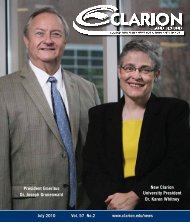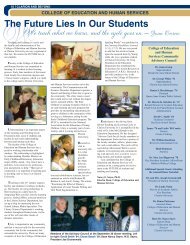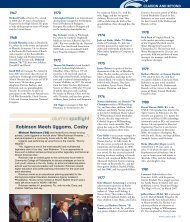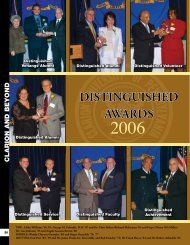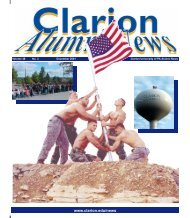Spring 2012 - Clarion University
Spring 2012 - Clarion University
Spring 2012 - Clarion University
You also want an ePaper? Increase the reach of your titles
YUMPU automatically turns print PDFs into web optimized ePapers that Google loves.
Karen smith, Ph.D.<br />
english<br />
Chair, wgs advisory Council<br />
aRaDicaL<br />
New<br />
FieLD<br />
As <strong>Clarion</strong> <strong>University</strong>’s Women and Gender Studies Program<br />
celebrates its 20th anniversary, we should be proud of the part we have<br />
played in the history of a nationally recognized academic discipline. Today<br />
there are over 650 Women’s Studies programs throughout the country<br />
including fifteen Ph.D. programs. Women’s Studies is now widely recognized<br />
as an academic field that prepares students for social justice advocacy<br />
and for working with diverse populations. But this was not always the case.<br />
Forty years ago, when the first programs were established at SUNY-Buffalo<br />
and San Diego State <strong>University</strong>, Women’s Studies was seen as a radical<br />
new field that challenged not only what was taught at the college level<br />
but also how it was taught. The first Women’s Studies classes were modeled<br />
on the consciousness-raising groups of the feminist movement in the 1960s<br />
and 1970s, where, by listening to each other’s stories, women became more<br />
aware of the ways in which a patriarchal society limited their opportunities<br />
and distorted the ways they saw themselves. In the Women’s Studies<br />
classroom, this model became a powerful tool for challenging the patriarchal<br />
nature of higher education, where traditionally women had been excluded<br />
or segregated as students, and where the contributions of women as<br />
scholars, artists, writers and scientists were usually overlooked.<br />
When our Women’s Studies minor program began in 1992, courses<br />
like Images of Women in Literature, Psychology of Women, and Philosophy<br />
and Women reflected the need to focus on the half of humanity that had<br />
been historically neglected in different academic disciplines. In addition to<br />
learning about women’s experiences and contributions, students were also<br />
encouraged to follow the feminist model of community action by becoming<br />
involved with PASSAGES, Inc., and S.A.F.E., and twelve years ago, the first<br />
performance of The Vagina Monologues added a new level of visibility<br />
to the program as well as a new venue for advocating against domestic<br />
violence, both locally and internationally. Today, the field of Women’s<br />
Studies is exploding with change, and our program is changing along with it.<br />
Topics such as eating and food, global feminism, girl culture, women’s health,<br />
women and the environment, sexualities, masculinity, transgender experience<br />
and the intersections between racial, gender, sexual, and class identities<br />
have all been moving Women’s Studies—now called Women and Gender<br />
Studies—forward into an interdisciplinary future. At <strong>Clarion</strong>, we anticipate<br />
more interdisciplinary courses covering these topics, especially on global<br />
issues, LGBT issues and the intersections of race and gender. While the<br />
consciousness-raising origins and community action goals of our courses<br />
are still very much alive, our classroom teaching will take on new forms as we<br />
move into offering more online courses and degrees. It is an exciting time for<br />
Women and Gender Studies across the country. As we begin our next 20<br />
years, I think it will be a time of new possibilities for us here at <strong>Clarion</strong> as well.<br />
13<br />
National Women’s Studies Association<br />
Leading the field of women’s studies in educational and social transformation





